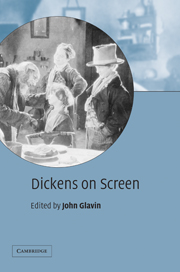Book contents
- Frontmatter
- Contents
- List of illustrations
- Notes on the contributors
- Acknowledgments
- Introduction
- Part I
- Part II
- Part III
- 8 Writing after Dickens: the television writer's art
- 9 Directing Dickens: Alfonso Cuaron's 1998 Great Expectations
- 10 Playing Dickens: Miriam Margolyes
- Part IV
- Part V
- Index
- References
8 - Writing after Dickens: the television writer's art
Published online by Cambridge University Press: 22 September 2009
- Frontmatter
- Contents
- List of illustrations
- Notes on the contributors
- Acknowledgments
- Introduction
- Part I
- Part II
- Part III
- 8 Writing after Dickens: the television writer's art
- 9 Directing Dickens: Alfonso Cuaron's 1998 Great Expectations
- 10 Playing Dickens: Miriam Margolyes
- Part IV
- Part V
- Index
- References
Summary
In considering the topic of Dickens and film, I cannot help but begin in the first-person singular. It is after all the singularity of my point of view that I began my professional life with the academic study and teaching of Dickens, and with Dickens and Reality (Columbia University Press) in 1980. Shortly afterwards I fell into bad company and drifted into the career of writing for movies and TV. I am not sure that I have ever managed to reconcile the two lobes of my brain, labeled respectively “Dickens” and “film.” The scripts I have written mostly depict (as Hollywood movies and television mostly do depict) lawyers and doctors and cops, in contemporary urban settings. Occasionally someone has asked me to adapt Dickens for the (American) screen, and I have declined on the grounds that the British do period pieces better. As for “updating” a Dickens novel, the 1999 movie of Great Expectations which translated the story and characters to contemporary Florida and Manhattan cast a kind of pall over the whole idea. Its failure at the box office was a tribute to the literary acuity of the mass audience.
And yet, setting aside the idea of adapting Dickens directly, I have often had the sense that Dickens's art has a sharp and specific relevance to the scripts I do write – the sense that he was a pre-visionary teacher of the arts of screenwriting, and, indeed, of filmmaking, that were to arise in the century after him.
- Type
- Chapter
- Information
- Dickens on Screen , pp. 89 - 94Publisher: Cambridge University PressPrint publication year: 2003



